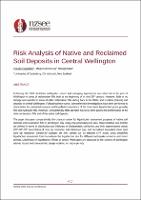| dc.description.abstract | Following the 2016 Kaikōura earthquake, severe and damaging liquefaction was observed at the port of Wellington in areas of reclamation fills built at the beginning of or mid 20th century. However, little or no damage was reported in areas of older reclamation fills, dating back to the 1850s, and in native (natural) soil deposits in central Wellington. Following these events, comprehensive investigations have been performed to characterise the undrained response and liquefaction resistance of the most resent liquefaction-prone gravelly fills and hydraulic fills. However, comparatively little attention has so far been paid to the performance of the older reclamation fills and of the native soil deposits.
The paper discusses comparatively the characterisation for liquefaction assessment purposes of native soil deposits and reclamation fills in Wellington city using cone penetration test data. Representative soil profiles are defined in terms of distribution and thickness of characteristic soil layers, and their representative values (25th-50th-75th percentiles) of cone tip resistance, soil behaviour type, and normalised equivalent clean sand cone tip resistance. Sensitivity analyses are then carried out on selected CPT traces using simplified liquefaction assessment tools to evaluate the liquefaction risk for different earthquake scenarios and return periods. Likelihood of liquefaction effects in central Wellington are discussed in the context of Wellington seismic hazard and characteristic design motions, i.e. return periods. | |

